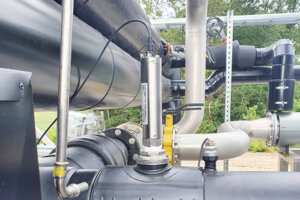Smart strategies for H2S removal from Biogas
In this insights post, we explore strategies for smart H2S removal from biogas and how you can leverage the power of sensor data for targeted mitigation strategies.

Introduction
Biogas is a key renewable energy source in the green transition, yet efficient production is often hindered by the challenges posed by hydrogen sulfide gas. Effectively addressing this challenge is crucial for maximizing biogas utility and profitability. This insights story explores the complexities of H2S removal from biogas, an essential process for ensuring safety, preserving the longevity of equipment, and ensuring cost-effective gas production.
What is H2S and why is it a challenge?
 Hydrogen sulfide (H2S), a colorless gas, is widely recognized for its distinct rotten egg smell. In the context of biogas production, H2S extends beyond being a mere olfactory issue; it presents several significant challenges:
Hydrogen sulfide (H2S), a colorless gas, is widely recognized for its distinct rotten egg smell. In the context of biogas production, H2S extends beyond being a mere olfactory issue; it presents several significant challenges:
- Corrosion: H2S’s highly corrosive nature can lead to significant issues in biogas plants. It can cause deterioration of pipes and storage facilities, leading to increased maintenance costs. The corrosion can also result in unscheduled downtime, disrupting normal operations and incurring additional costs.
- Health Hazard: Exposure to H2S poses serious health risks. Even at low concentrations, it can cause respiratory problems, and at high levels, it can be lethal.
- Environmental Impact: When biogas containing H2S is used as fuel, its combustion process releases sulfur dioxide, a pollutant contributing to air pollution and environmental degradation.
- Operational Challenges: Accurate H2S measurements are crucial for efficient gas production, for safety, and for cost-optimizing desulfurization processes. This includes timing filter changes accurately or setting the correct dosages for treatment methods. Challenges in obtaining precise measurements due to the need for extensive maintenance and preconditioning of gas can lead to unscheduled plant downtime or the need for flaring, adversely affecting productivity and environmental compliance.
For more information about what H2S is, we recommend our Guide to understanding H2S.
Sources of H2S in biogas
The concentration of H2S in biogas is significantly influenced by the feedstock used in the anaerobic digestion process. Materials rich in sulfur compounds, such as certain types of agricultural waste (e.g., manure from poultry or swine), food waste, and industrial effluents, are known to lead to higher H2S levels. The decomposition of these materials under anaerobic conditions results in the release of H2S. Understanding the sulfur content in various feedstocks is crucial for predicting and managing H2S levels in biogas production.
- Agricultural Waste: Manure and crop residues often contain sulfur compounds that contribute to H2S formation.
- Industrial Effluents: Wastewater from industries like paper mills and food processing can be high in sulfur.
- Organic Waste: Food waste and other organic matter are common contributors to H2S in biogas.
Measuring H2S in biogas
Accurate hydrogen sulfide measurements are crucial both for safety and efficiency, but the demanding conditions of biogas production present a challenge for sensor technologies. H2S monitoring needs can be divided into two main areas: personal safety and process gas monitoring, each requiring distinct sensors.
Sensors for safety

Sensors for process efficiency

Techniques for H2S removal from biogas
The removal of hydrogen sulfide (H2S) from biogas involves various methods, each dealing with different degrees of desulfurization. Some methods are ideal for first-stage desulfurization, while others, like membrane systems, are aimed at upgrading biogas to biomethane as a final cleaning step.
Feedstock/digester treatment
Effective biogas production begins with managing hydrogen sulfide levels at the source. Treating feedstock and digesters is crucial for mitigating H2S formation and ensuring smooth plant operation.
- Iron Salts Dosing: Iron salts, such as ferrous chloride or ferric chloride, can be dosed into the biogas stream. These salts react with H2S to form insoluble iron sulfides, effectively reducing H2S levels. This method is advantageous for its simplicity and effectiveness, especially in treating high H2S concentrations. However, it requires careful management of dosing rates and can produce sludge as a byproduct, necessitating proper disposal.
- Aeration: Aeration involves introducing air or oxygen into the biogas, promoting the oxidation of H2S to elemental sulfur or sulfate. This method is particularly effective in systems where biological treatment is feasible. The process reduces H2S without the need for chemical additives, making it an environmentally friendly option. However, it requires careful control of oxygen levels to avoid compromising the methane content of the biogas and may not be suitable for systems with extremely high H2S concentrations.
Adsorption Techniques
Adsorption involves molecules sticking to the surface of a solid material. In biogas, it’s used to capture H2S molecules, improving gas quality. This method is efficient, simple, and adaptable to different H2S levels, making it ideal for biogas purification.
- Water scrubbing: Water scrubbing involves passing biogas through water, where H2S is absorbed. It’s effective for moderate H2S levels but less so for very high concentrations. The process is simple and uses readily available water, but the H2S-saturated water requires proper treatment or disposal. This method is cost-effective but may lead to some methane loss, necessitating careful process control.
- Iron Hydroxide Scrubbing: This process involves a chemical reaction between H2S and iron hydroxide. It’s highly effective across a wide range of H2S concentrations and can be adapted to different scales. The iron hydroxide used in this process can often be regenerated, but the method does involve handling chemicals, and the regeneration process can add complexity.
- NaOH Scrubbing: Sodium hydroxide (NaOH) scrubbing passes biogas through a NaOH solution, which reacts with and removes H2S. This method is particularly effective for high H2S concentrations and can handle fluctuating levels of H2S. However, it produces waste products that require disposal, and handling NaOH requires strict safety measures.
Biological Treatment
Biological treatment is an eco-friendly method for sulfide mitigation using natural processes. This makes it a sustainable and effective solution for biogas purification.
- Biofilters: Biofilters use microorganisms to oxidize H2S into less harmful substances. This environmentally friendly method is particularly cost-effective for lower H2S concentrations. However, it requires control of environmental conditions and is less effective for high concentrations of H2S.
- Bioscrubbers: These systems combine physical absorption and biological oxidation. Biogas is first passed through a scrubbing solution where H2S is absorbed, and then microorganisms in a bioreactor oxidize the absorbed H2S.
Absorption Techniques
Absorption involves the gas being dissolved into a liquid. In biogas, it’s a method used to remove H2S by dissolving it into a solvent. This approach is effective in removing H2S from the gas stream, improving its quality without introducing additional chemicals. It’s a versatile and efficient method for biogas purification.
- Activated Carbon Filters: Activated carbon filters are highly effective in removing H2S and other impurities from biogas. They are particularly useful for their high adsorption capacity. However, similar to other adsorption methods, the carbon filters need regular replacement or regeneration.
- Iron Oxide Pellets: Iron oxide pellets chemically react with H2S to form iron sulfide, effectively removing H2S from biogas. This method is suitable for moderate levels of H2S and allows for pellet regeneration. However, it requires careful handling and storage of the pellets, and the regeneration process can be complex.
Membrane systems
- Membrane Separation: Membrane separation uses selective membranes that allow H2S to pass through while retaining methane. This method results in a high-purity product gas and has a low energy requirement. The initial investment can be high, and the membranes may be prone to fouling, which requires maintenance.
Each method offers distinct advantages and challenges. The choice of the most appropriate H2S removal strategy depends on various factors, including the biogas plant’s specific needs, the composition of the biogas, the desired quality of the end product, and budget considerations. Often, a combination of these methods is employed to achieve optimal H2S removal efficiency.
Smart strategies for H2S removal
For implementing smart strategies in H2S removal from biogas, a thorough understanding of the biogas composition and H2S levels is crucial. This understanding forms the basis for integrating the most suitable H2S removal system into an existing biogas plant, taking into account factors like space, compatibility, and cost. However, the key to truly optimizing these systems lies in the continuous and accurate measurement of hydrogen sulfide levels, which is essential for the efficiency and effectiveness of the desulfurization process.

Inline H2S sensor measuring in wet biogas
The challenge in obtaining reliable hydrogen sulfide data stems from the limitations of current sensor technologies. These sensors often require complex installation, regular maintenance, calibration, and sometimes preconditioning of the biogas for accurate readings. Overcoming these challenges is vital, as accurate H2S data are instrumental in optimizing the desulfurization setup:
- Correct Dosage Setting: The effectiveness of chemical and biological methods for H2S removal heavily depends on the accurate dosing of reactive agents or nutrients. Sensor data help in determining the right amount of chemicals or biological agents needed, ensuring efficient H2S removal without overuse or underuse of resources. This article explores 3 smart strategies for dosing control as an alternative to fixed dosing.
- Ensuring Filter Lifespan: In physical adsorption methods, like activated carbon filters, the lifespan of the filter material is directly related to the H2S concentration in the biogas. Reliable sensor data allow for timely replacement or regeneration of these filters, preventing breakthroughs and ensuring continuous, effective operation.
- Verifying Effectiveness of Removal Methods: Accurate H2S measurements are crucial for assessing the effectiveness of the implemented desulfurization strategies. Continuous monitoring helps in identifying any inefficiencies or malfunctions in the system, allowing for prompt adjustments or repairs.
- Compliance and Safety: Adhering to safety standards and regulatory requirements often necessitates precise control of H2S levels. Accurate sensor data ensure that the biogas plant operates within the legal limits, avoiding potential fines and ensuring the safety of the workforce.
Selecting the right sensors for the specific conditions of the biogas plant is therefore critical. This selection should consider factors such as the range of H2S concentrations expected, the environmental conditions at the plant, and the specific requirements of the desulfurization process. Regular maintenance and calibration of these sensors are equally important to ensure their accuracy and reliability over time.
Conclusion
The removal of H2S from biogas is essential for ensuring safety, environmental compliance, and operational efficiency. A thorough understanding of H2S, coupled with the right removal and monitoring strategies, is key to maximizing the potential of biogas. By prioritizing H2S removal, biogas can be a sustainable and safe energy solution.
New whitepaper - Smart H2S control in biogas
Managing hydrogen sulfide at the biogas plant is challenging without the right data.
Download our new whitepaper and get a framework and practical tips for how you can use reliable sensor measurements to make smarter decisions when controlling odor, corrosion, and worker safety challenges at the biogas plant.

